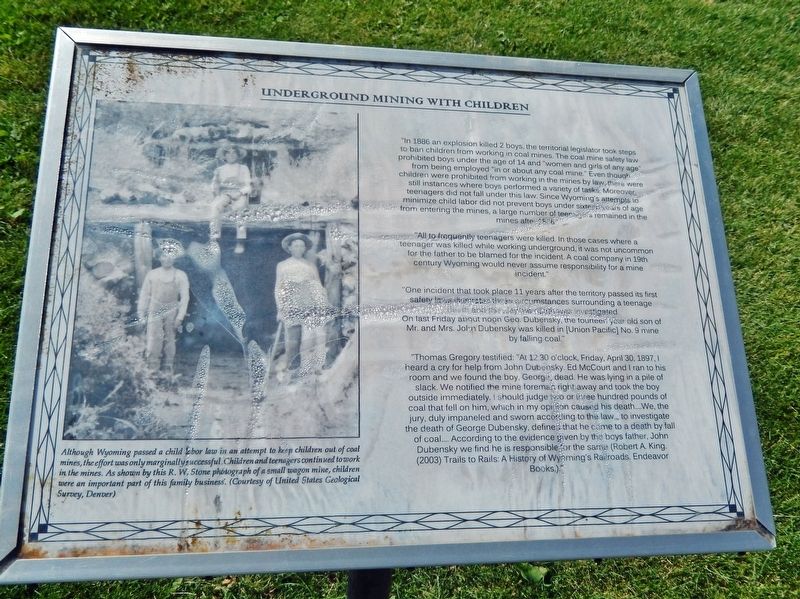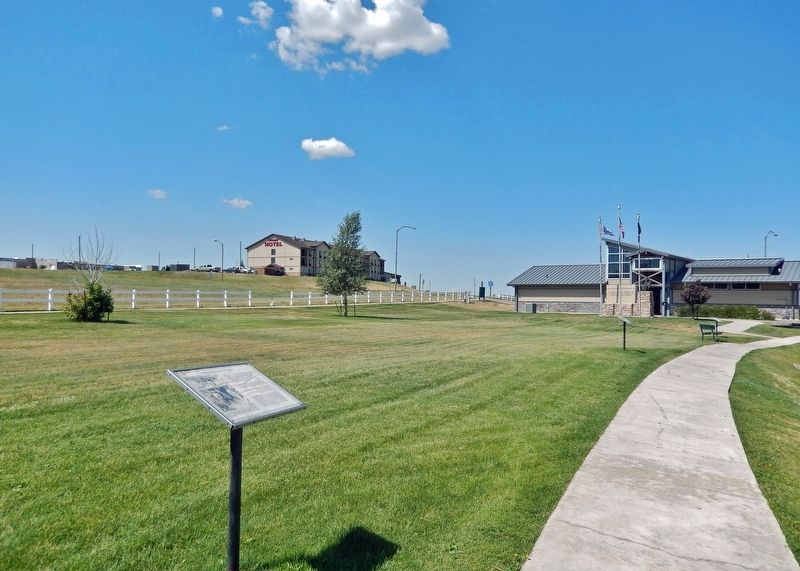Wright in Campbell County, Wyoming — The American West (Mountains)
Underground Mining with Children
"In 1886 an explosion killed 2 boys, the territorial legislature took steps to ban children from working in coal mines. The coal mine safety law prohibited boys under the age of 14 and "women and girls of any age" from being employed "in or about any coal mine." Even though children were prohibited from working in the mines by law, there were still instances where boys performed a variety of tasks. Moreover, teenagers did not fall under this law. Since Wyoming's attempts to minimize child labor did not prevent boys under sixteen years of age from entering the mines, a large number of teenagers remained in the mines after 1886."
"All too frequently teenagers were killed. In those cases where a teenager was killed while working underground, it was not uncommon for the father to be blamed for the incident. A coal company in 19th century Wyoming would never assume responsibility for a mine incident."
"One incident that took place 11 years after the territory passed its first safety laws illustrates these circumstances surrounding a teenage death and the way the death was investigated. On last Friday about noon Geo. Dubensky, the fourteen year old son of Mr. and Mrs. John Dubensky was killed in [Union Pacific] No. 9 mine by falling coal."
"Thomas Gregory testified: "At 12:30 o'clock, Friday, April 30, 1897, I heard a cry for help from John Dubensky. Ed McCourt and I ran to his room and we found the boy, George, dead. He was lying in a pile of slack. We notified the mine foremen right away and took the boy outside immediately. I should judge two or three hundred pounds of coal that fell on him, which in my opinion caused his death… We, the jury, duly impaneled and sworn according to the law… to investigate the death of George Dubensky, define that he came to a death by fall of coal… According to the evidence given by the boy’s father, John Dubensky, we find he is responsible for the same (Robert A. King. (2003) Trails to Rails: A History of Wyoming's Railroads. Endeavor Books)."
[photo caption]
Although Wyoming passed a child labor law in an attempt to keep children out of coal mines, the effort was only marginally successful. Children and teenagers continued to work in the mines. As shown by this R. W. Stone photograph of a small wagon mine, children were an important part of this family business.
Topics. This historical marker is listed in these topic lists: Industry & Commerce • Law Enforcement. A significant historical date for this entry is April 30, 1897.
Location. 43° 45.731′ N, 105° 28.881′ W. Marker is in Wright, Wyoming, in Campbell County. Marker can be reached from the intersection of State Highway 387 and Ranch Drive, on the right
when traveling west. Marker is located on the Wright Visitor Center & Centennial Museum grounds. Touch for map. Marker is at or near this postal address: 15089 Wyoming Highway 387, Wright WY 82732, United States of America. Touch for directions.
Other nearby markers. At least 7 other markers are within walking distance of this marker. The Beginning of Coal Mining in Wyoming (a few steps from this marker); The Building of Wright, Wyoming (within shouting distance of this marker); Veterans Memorial (within shouting distance of this marker); Tertiary (Paleogene) Period (within shouting distance of this marker); The Beginning of Wright, a Company Town (about 400 feet away, measured in a direct line); Ranching in Wyoming (about 400 feet away); Lectra Haul Unit Rig (about 800 feet away).
Also see . . . The Most Dangerous Occupation: The Quest for Safety in Wyoming’s Coal Mines. Excerpt:
Before 1886, Wyoming mines were entirely unregulated. As a result, mine tragedies were frequent. The first mine disaster came in March 1881 near Almy, Wyo., north of Evanston. An explosion and fire killed 38 miners and destroyed several surface buildings. Five years later, at the same mine, 13 miners, including two young boys, died in another explosion. The Wyoming Territorial Legislature was about to convene just days after the second mine disaster at Almy. In short order, legislators passed new mine safety laws. The new law created the office of state mine inspector with the duty of inspecting every coal mine in Wyoming no less frequently than every three months. Further, the act banned boys under 14 from working underground. Women were also “protected” from the hazards of mining when it was made unlawful for them to work in mines.(Submitted on March 13, 2024, by Cosmos Mariner of Cape Canaveral, Florida.)
Credits. This page was last revised on March 13, 2024. It was originally submitted on March 13, 2024, by Cosmos Mariner of Cape Canaveral, Florida. This page has been viewed 47 times since then. Photos: 1, 2. submitted on March 13, 2024, by Cosmos Mariner of Cape Canaveral, Florida.

